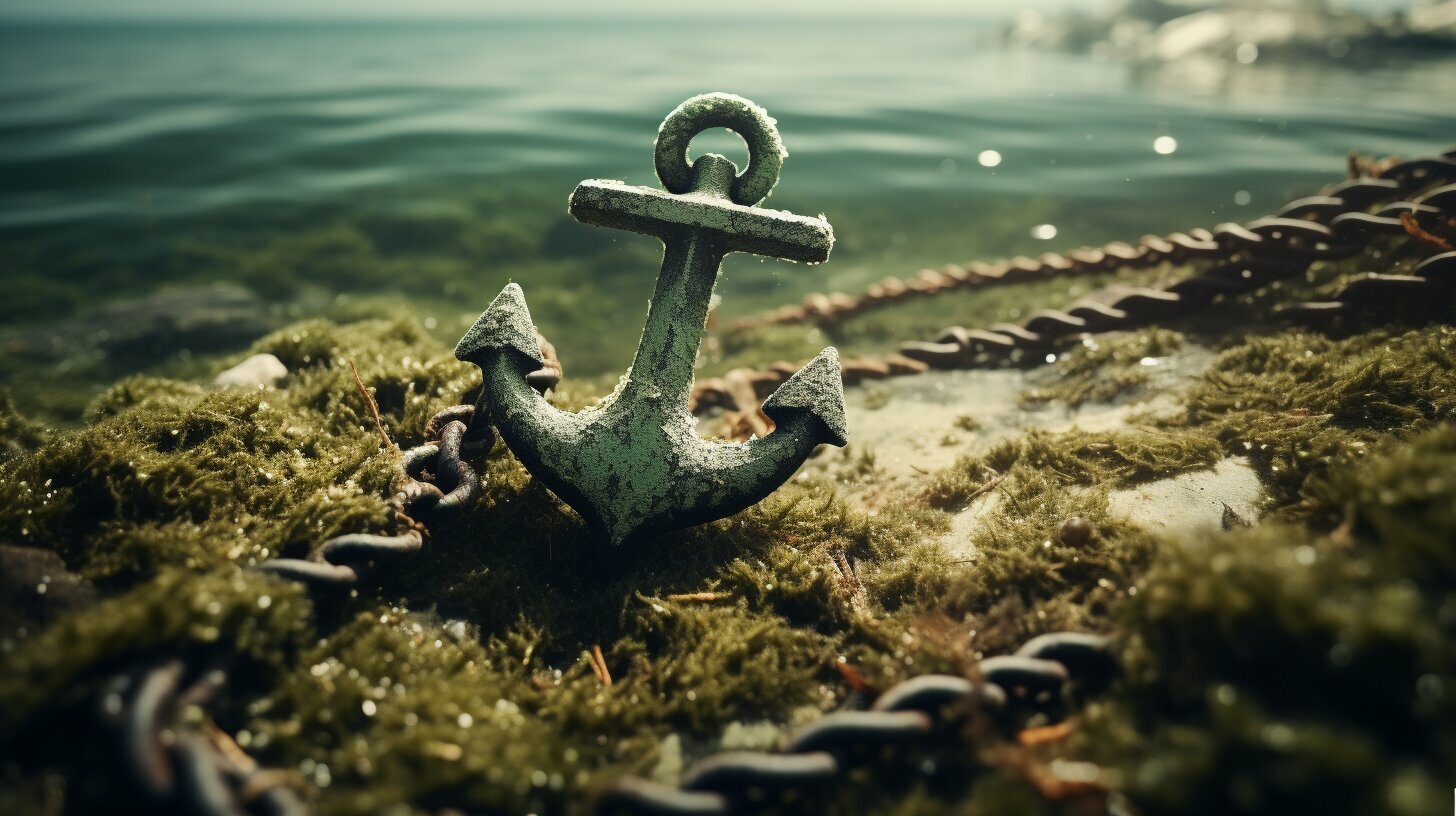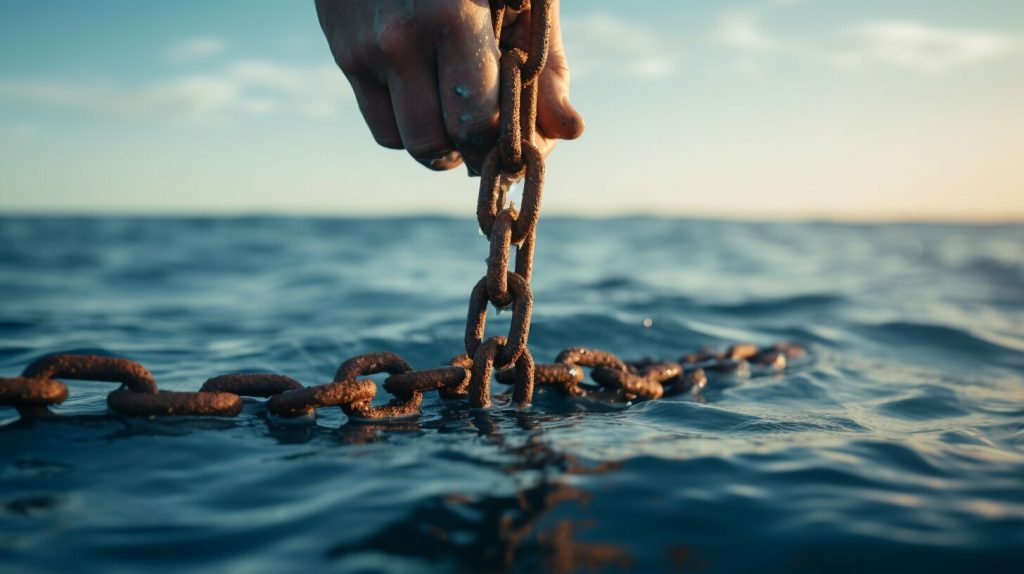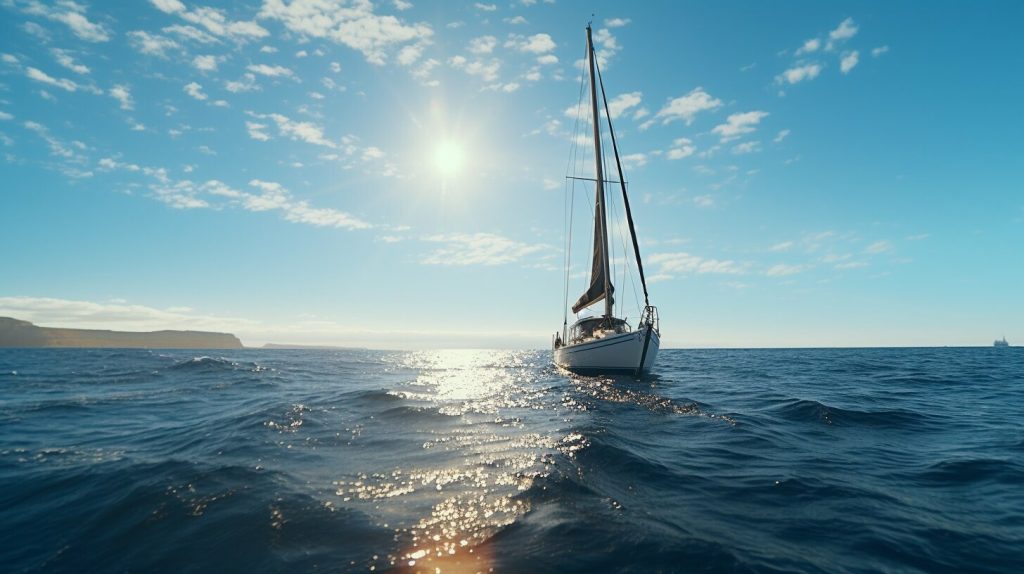Anchoring a sailing boat is a fundamental skill that every sailor should master. Whether you’re a beginner or looking to enhance your anchoring techniques, this comprehensive guide will walk you through the essential steps to ensure a worry-free sailing experience in the US waters.
- Proper planning and research are crucial for identifying the perfect anchor location.
- Hang the anchor below the surface to prevent it from bouncing into your bow.
- Position the boat with the bow against the wind for stability.
- Pay out the appropriate scope of chain to ensure a secure hold.
- Rig up a snubber or bridle to minimize strain on the windlass.
Planning and Research: Identifying the Perfect Anchor Location
The first step in anchoring a sailing boat is to thoroughly plan and research the anchor location. This involves considering various factors such as the protection level and potential obstacles in the area. By taking the time to identify a secure boat anchorage, you can ensure a worry-free sailing experience.
“A well-chosen anchor location is key to the safety and stability of your boat,” says experienced sailor John Smith. “You want to find a spot that provides adequate shelter from wind and waves, while also avoiding hazards like rocks, reefs, or other vessels.”
To assist with your planning, refer to charts, navigation tools, and local knowledge to determine the most suitable anchor location. Look for areas with good holding ground, such as sand or mud, as these provide a secure grip for the anchor. Additionally, consider the depth of the water, ensuring it is suitable for your boat’s draft and the length of chain you have available.
Remember, the more effort you put into planning and researching your anchor location, the more confident and secure you will feel during your sailing adventures.
Recommended Anchor Location Checklist
| Factors to Consider | Checklist |
|---|---|
| Protection level | Is the area sheltered from wind and waves? |
| Obstacles | Are there any rocks, reefs, or other vessels to avoid? |
| Holding ground | Is the sea floor composed of sand or mud for a secure grip? |
| Water depth | Is the depth suitable for your boat’s draft and chain length? |
By following these sailboat anchoring techniques and ensuring a secure boat anchorage, you can set sail with confidence and enjoy a relaxing and worry-free time on the water.
Disclaimer: The information presented in this article is for educational purposes only. It is important to consult local regulations, guidelines, and experienced sailors for specific advice on anchoring locations and techniques.
Getting the Anchor Ready: Hanging it Below the Surface
Ensuring that your anchor is ready for deployment is essential for a successful anchoring experience. Before dropping it into the water, you need to hang the anchor below the surface to prevent it from bouncing into your boat’s bow. Understanding the different types of boat anchors and their uses will help you choose the most suitable one for your sailing vessel.
Here are a few essential sailing boat anchoring skills to prepare your anchor:
- Select the Right Anchor: Different types of anchors work best in different conditions. Consider the seabed composition, water depth, and boat size when choosing the anchor that provides optimal holding power.
- Prepare the Anchor Chain: Check the condition of your anchor chain for any signs of wear or damage. Ensure that it is properly connected to the anchor and is free from any tangles or knots.
- Attach the Anchor to the Bow: Securely attach the anchor to the bow of your boat using a bow roller or equivalent attachment point. This will ensure smooth deployment and retrieval of the anchor.
Remember, having a properly prepared anchor will give you peace of mind while sailing, knowing that you have taken the necessary steps to ensure a secure anchorage.
Now that your anchor is ready, you can move on to the next step: locating the anchoring spot and positioning your boat for a safe and stable anchor deployment.
| Anchor Type | Best Use |
|---|---|
| Fluke (Danforth) Anchor | Best for sandy or muddy bottoms |
| Plow (CQR) Anchor | Great for various seabed conditions |
| Delta Anchor | Ideal for rocky or weedy bottoms |
Remember, it’s important to have a clear understanding of the boat anchors and their uses to ensure a successful anchoring experience. Stay tuned for the next section where we discuss locating the anchoring spot and positioning your boat for a secure and worry-free anchorage.
Properly locating the anchoring spot and positioning your boat is crucial for a successful anchor drop. Before dropping the anchor, it’s important to take into account the protection level and potential obstacles in the area. Choosing the right spot will ensure a secure and stable position for your sailing vessel.
When positioning the boat, make sure to face the bow against the wind. This will help maintain stability during the anchoring process. By keeping the bow pointing into the wind, you minimize the risk of the boat swinging or drifting off course. Implementing these best practices will help you anchor with confidence.
Remember, the wind and current might affect your boat’s position, so stay mindful of any changes and make adjustments as needed. Taking the time to properly position your boat before dropping the anchor sets the foundation for a successful anchorage and a worry-free sailing experience.
Table 1: Factors to Consider When Locating the Anchoring Spot
| Factors | Considerations |
|---|---|
| Protection Level | Look for a location with natural barriers such as cliffs, reefs, or a well-sheltered cove that can protect your boat from strong winds, waves, and currents. |
| Obstacles | Identify any potential hazards such as underwater obstructions, other boats, or restricted areas. Avoid anchoring in busy shipping channels or areas with strong tidal flows. |
| Bottom Type | Consider the composition of the seabed, as it affects the anchor’s holding power. Soft mud or sand provides better holding than rocky or grassy bottoms. |
| Swing Room | Ensure you have enough space for your boat to swing 360 degrees with changes in wind and tide. Calculate the swing radius based on water depth and the length of your vessel. |
Dropping the Anchor: Paying Out the Scope of Chain
Dropping the anchor and paying out the necessary chain is a critical step in anchoring a sailing boat. Once you have identified the perfect spot to anchor, position your boat with the bow against the wind to ensure stability. With the anchor ready to be deployed, carefully lower it into the water, allowing it to reach the desired spot. Remember to pay out enough scope of chain, ensuring it is appropriate for the water depth. This will provide enough slack for the anchor to set properly and hold your boat securely.
When paying out the chain, it is essential to maintain control and avoid it tangling or twisting. Use a steady and controlled motion, allowing the chain to flow freely without any sudden jerks. If necessary, you can use your hand or a winch handle to guide the chain and prevent any snags or jams.
Once the anchor has reached the bottom, firmly secure the chain, ensuring it is not tangled or wrapped around any obstacles. Remember to never tie off the chain to the stern of the boat, as this can compromise the stability and safety of the vessel. Instead, use appropriate sailing boat anchoring techniques to secure the chain to the bow and distribute the load evenly.
| Key Points: |
|---|
| Position your boat with the bow against the wind |
| Pay out enough scope of chain for the water depth |
| Avoid tangling or twisting of the chain |
| Secure the chain to the bow, not the stern |
Expert Tip:
“Remember to always double-check the anchor’s grip by slowly reversing the boat, putting tension on the chain. This test will help ensure a secure and reliable hold.”
Paying out the chain correctly is crucial for a safe and secure anchorage. It allows the anchor to establish a firm grip on the seabed, providing stability and peace of mind for your sailing adventure. By following these safe sailing boat anchoring methods, you can confidently enjoy your time on the water while knowing your boat is securely anchored.
Rigging a snubber or bridle is an essential step in ensuring the stability and security of your boat anchor. By distributing the load and reducing strain on the windlass, these sailing boat anchoring techniques provide a strong and reliable hold. To rig up a snubber or bridle, follow the steps below:
- Attach the snubber or bridle line to the anchor chain using a strong and secure knot, such as a bowline or a rolling hitch.
- Lead the snubber or bridle line to a strong attachment point on the boat, such as a cleat or a dedicated attachment point.
- Tension the snubber or bridle line, ensuring it is tight enough to take the load off the windlass but not so tight that it puts unnecessary strain on the boat.
- Secure the snubber or bridle line to the attachment point, ensuring it is firmly in place.
By following these sailboat anchoring techniques, you can enjoy a more secure and stable anchorage, minimizing the risk of the anchor slipping or dragging. Remember to regularly check the tension of the snubber or bridle line and make adjustments as necessary to maintain a safe and secure hold.
Take a look at the complete table below for a quick overview of the steps involved in rigging a snubber or bridle:
| Steps | Description |
|---|---|
| 1 | Attach snubber or bridle line to the anchor chain |
| 2 | Lead line to a strong attachment point on the boat |
| 3 | Tension the line to take load off the windlass |
| 4 | Secure the line to the attachment point |
With your snubber or bridle properly rigged, you can feel confident in the stability and security of your boat anchor, allowing you to relax and enjoy your time on the water.
Tensioning the chain and testing the ground tackle’s holding is a crucial step in ensuring the effectiveness of your anchor. By properly tensioning the chain, you can determine if your anchor is securely holding the boat in place. This step is especially important when anchoring in different weather conditions, as it will give you confidence in the anchor’s ability to withstand strong winds and currents.
To tension the chain, start by slowly motoring the boat forward while maintaining tension on the anchor rode. This will allow you to feel the resistance and judge how well the anchor is holding. Keep a close eye on the anchor rode as it enters the water, ensuring it remains taut and does not go slack. If the anchor starts dragging or the chain becomes loose, it may indicate that the anchor needs to be repositioned or a different anchoring spot should be considered.
Testing the ground tackle’s holding can be done by observing the position of fixed landmarks or using a GPS plotter to monitor the boat’s drift. If the boat remains in the desired location and does not move significantly, it indicates that the anchor is securely holding. However, if the boat continues to drift or veer off course, it may be necessary to re-drop the anchor and repeat the anchoring process to ensure a safe and secure hold.
Testing the Ground Tackle’s Holding – Recommended Tools
- GPS plotter or navigation system
- Binoculars
- Fixed landmarks or reference points
| Weather Conditions | Recommended Scope of Chain |
|---|---|
| Calm weather and light wind | 3:1 ratio (three times the depth of the water) |
| Moderate wind and current | 5:1 ratio |
| Strong wind and current | 7:1 or greater ratio |
Remember, anchoring in different weather conditions requires adjusting the scope of chain to ensure adequate holding power. The table above provides general guidelines for the recommended scope ratios based on various weather conditions. However, it’s important to note that these ratios may vary depending on factors such as the type of anchor, seabed conditions, and the size of your boat.
By following these boat anchoring tips and properly tensioning the chain, you can have peace of mind knowing that your anchor is secure, allowing you to enjoy your time on the water without any worries.
Repeat if Necessary: Re-Dropping the Anchor
In cases where the anchor fails the initial holding test, it is necessary to re-drop the anchor and repeat the process. This can happen if the anchor does not grip the seabed securely or if external factors such as strong currents or winds are affecting its holding power. To ensure a secure and stable anchorage, it is crucial to take immediate action and follow these sailboat anchoring techniques:
- Retrieve the anchor by slowly motoring towards it while pulling in the rope. Take care to avoid any sudden jerks or movements that may destabilize the boat.
- Inspect the anchor for any visible issues or entanglements that may have caused the previous failure.
- Choose a new anchoring spot that meets the desired criteria of protection and obstacle-free surroundings.
- Position the boat with the bow against the wind, ensuring stability during the re-anchoring process.
- Drop the anchor at the new spot and pay out the appropriate scope of chain, ensuring it is enough for the water depth.
- Rig up a snubber or bridle to distribute the load off the windlass, reducing strain and ensuring proper holding power.
- Tension up the chain and test the ground tackle’s holding, adjusting the tension according to the prevailing weather conditions.
By repeating the anchoring process, you give yourself another opportunity to secure your vessel and enjoy a worry-free sailing experience. Remember to always observe safe sailing practices and consult local regulations and guidelines for specific anchoring requirements in your area.
Retrieving the Anchor: Slowly Motoring Towards It
Retrieving the anchor requires careful maneuvering and adherence to boat anchoring tips and sailboat anchoring techniques. Once you’re ready to head back out onto the water, follow these essential steps to ensure a smooth and efficient retrieval process.
First, slowly motor towards the anchor while simultaneously pulling in the rope. Maintain a steady pace to avoid causing excessive strain or jerking motions. By taking your time, you can prevent any potential damage to the boat or anchor.
As you approach the anchor, keep a close eye on the surroundings to avoid any obstacles or other vessels in the vicinity. Clear communication among the crew members is essential to ensure a safe retrieval without any accidents or mishaps.
Once the anchor is within reach, grab hold of the rope firmly and guide it onto the boat. Carefully secure the anchor in a designated storage area, ensuring that it is well-protected and won’t pose any hazards during the rest of your sailing journey.
Remember, retrieving the anchor is just as important as dropping it properly. By following these boat anchoring tips and sailboat anchoring techniques, you can enjoy a worry-free sailing experience and maintain a secure anchorage throughout your journey.
Summary:
- Motor towards the anchor slowly and steadily while pulling in the rope.
- Be aware of your surroundings and avoid any obstacles or other vessels.
- Securely store the anchor in a designated area on the boat.
Important Reminder: Never Tie Off to the Stern
Tying off the anchor to the stern of the boat is a common mistake that should be avoided at all costs. Doing so can compromise the stability and safety of the vessel. Always follow proper boat anchoring tips and sailboat anchoring techniques to maintain a secure anchorage.
When anchoring, it’s crucial to position the boat with the bow against the wind. This helps maintain stability during the anchoring process. Dropping the anchor at the desired spot and paying out the appropriate scope of chain is essential for a secure hold. Understanding how to rig up a snubber or bridle can help distribute the load and protect the windlass from strain.
Testing the ground tackle’s holding is a critical step in ensuring a safe and secure anchorage. Tensioning the chain and adjusting it according to the weather conditions is key. It may be necessary to re-drop the anchor and repeat the anchoring process if the initial holding test fails. By following proper sailboat anchoring techniques, you can enhance your anchoring skills and confidently navigate the US waters.
Key Takeaways:
- Never tie off the anchor to the stern of the boat.
- Position the boat with the bow against the wind for stability.
- Drop the anchor at the desired spot and pay out the appropriate scope of chain.
- Rig up a snubber or bridle to distribute the load and protect the windlass.
- Tension the chain and adjust it according to the weather conditions.
- Re-drop the anchor if necessary and repeat the anchoring process.
Congratulations! You have now learned the essential steps and techniques for anchoring a sailing boat successfully. By mastering these skills, you can confidently navigate and enjoy worry-free sailing experiences in the US waters.
To anchor a sailing boat successfully, proper planning and research are crucial. Start by identifying the location where you want to anchor, considering factors such as the protection level and potential obstacles in the area. This will ensure a secure boat anchorage, setting the foundation for a worry-free experience.
Once you have chosen the ideal spot, get the anchor ready by hanging it below the surface. This will prevent it from bouncing into your bow, ensuring a smooth anchoring process. Pay attention to the different types of boat anchors and their uses, selecting the most suitable one for your sailing vessel.
Position your boat with the bow against the wind before dropping the anchor. This will provide stability and help maintain the desired anchoring spot. Pay out the appropriate scope of chain, carefully considering the water depth and implementing safe sailing boat anchoring methods.
Rigging up a snubber or bridle is a crucial step to distribute the load and protect the windlass. This sailing boat anchoring technique reduces strain and ensures the anchor’s proper holding. Tension up the chain and test the ground tackle’s holding, considering the weather conditions for a secure and stable anchorage.
If the anchor fails the initial holding test, do not hesitate to re-drop the anchor and repeat the anchoring process. Understanding sailboat anchoring techniques and having a secure boat anchorage backup plan is vital for such situations.
When it’s time to retrieve the anchor, remember to slowly motor towards it while pulling in the rope. Following proper boat anchoring tips and sailboat anchoring techniques will ensure a smooth and efficient retrieval process. And always remember, never tie off an anchor to the stern of the boat, as it can compromise stability and safety.
With these essential steps and techniques, you are now well-equipped to anchor a sailing boat successfully. Enjoy your sailing adventures with confidence and peace of mind!
FAQ
Q: What factors should I consider when identifying the perfect anchor location?
A: When choosing an anchor location, consider the protection level and potential obstacles in the area to ensure a secure boat anchorage.
Q: How should I get the anchor ready?
A: Hang the anchor below the surface to avoid it bouncing into your bow. Make sure to understand the different types of boat anchors and their uses to select the most suitable one for your sailing vessel.
Q: What is the best way to position the boat for anchoring?
A: Position your boat with the bow against the wind to maintain stability. This ensures that the boat remains securely in place during the anchoring process.
Q: How can I drop the anchor properly?
A: Drop the anchor at the desired spot and pay out the appropriate scope of chain to prevent dragging. This is essential for a secure and stable anchorage.
Q: How can I take the load off the windlass?
A: Rig up a snubber or bridle to distribute the load and minimize strain on the windlass. This will help ensure the anchor’s proper holding and keep your sailing boat secure.
Q: How can I test the holding of the ground tackle?
A: Tension up the chain after rigging the snubber or bridle to test the ground tackle’s holding. Adjust the tension according to the weather conditions for a safe and secure anchorage.
Q: What should I do if the anchor fails the initial test?
A: If the anchor fails the holding test, re-drop the anchor and repeat the anchoring process. Having a secure boat anchorage backup plan is crucial in such situations.
Q: How should I retrieve the anchor?
A: Slowly motor towards the anchor while pulling in the rope to retrieve it. Following proper boat anchoring tips and sailboat anchoring techniques ensures a smooth and efficient retrieval process.
Q: Is there anything I should never do when anchoring?
A: Never tie off an anchor to the stern of the boat. This can compromise the stability and safety of the vessel. Always follow boat anchoring tips and sailboat anchoring techniques for a secure anchorage.












